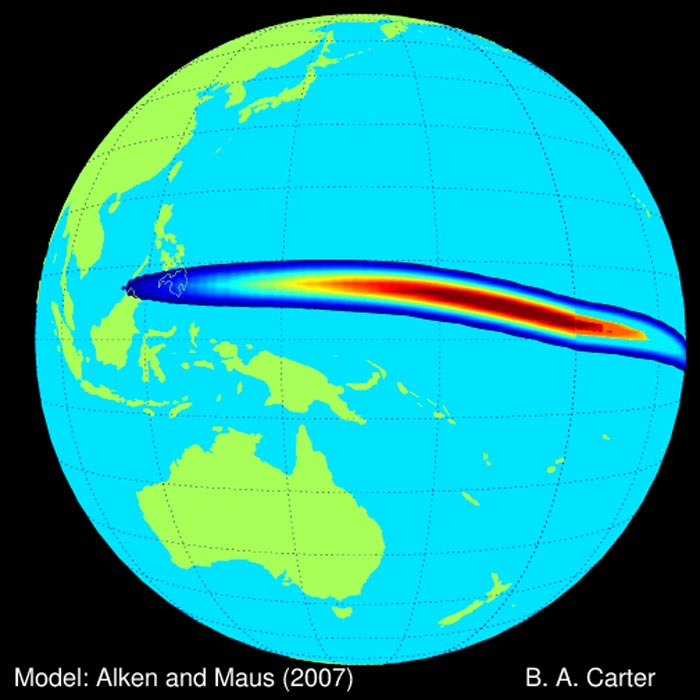

The equatorial electrojet is a naturally occurring flow of current approximately 100 kilometers (60 miles) above the surface of the Earth. New findings raise the issue of increasing power grid safeguards in regions previously thought to be less prone to space weather than high-latitude regions.
Credit: Brett A. Carter
Extreme space weather has long been seen as a threat to electrical grids in high-latitude regions of the northern and southern hemispheres. A new study finds that smaller space weather effects are amplified near the Earth’s equator, putting power grids at risk in regions long considered safe from bad space weather.
Massive space weather events have crashed power grids across North America and Europe, but the new report warns that smaller events strike – often with little warning – in equatorial regions with greater frequency than previously known, according to Brett Carter, a visiting scholar at Boston College’s Institute for Scientific Research in Massachusetts, and lead author of the article recently accepted for publication in Geophysical Research Letters, an American Geophysical Union journal.
These equatorial electrical disruptions – fueled by geomagnetically induced currents – pose a threat to power grids in countries where shielding electricity infrastructure from space shocks has not been a recognized priority, according to the study.
“These disturbances affect what’s happening in the equatorial region, which has largely been overlooked,” said Carter, a space physicist who is also affiliated with RMIT University’s SPACE Research Centre in Australia. “What the historical data also show is that we don’t need huge geomagnetic storms to experience the effects. They can also take place during what we might otherwise classify as ‘quiet’ periods of space weather.”
In other words, electrical disruptions in the equatorial region do not require severe geomagnetic storms, similar in scale to events that have crashed power grids in the past, most notably in Quebec in 1989 and in Sweden in 2003, according to the study.
Analyzing 14 years of data collected in space and on Earth, the team found that geomagnetically induced currents are amplified by the equatorial electrojet, a naturally occurring flow of current approximately 100 kilometers (60 miles) above the surface of the Earth. Wending its way through the Earth’s ionosphere along the magnetic equator, the electrojet travels above large swaths of Africa, South America, Southeast Asia and the southern tip of India.
In their report, Carter and his team, including researchers from RMIT and Dartmouth College, examined the effects of interplanetary shocks in the solar wind, which is the stream of charged particles that flows out of the sun. Massive explosions on the sun’s surface can cause these shocks, but many are created through far less violent means.
The arrival of these shocks at Earth causes complex phenomena in the Earth’s magnetosphere and ionosphere, which provokes spikes in current at the Earth’s surface, said Carter.
“The Earth’s magnetic field does the job of shielding the Earth from the solar wind and when it gets hit by these shocks, you get a global magnetic signature at the ground,” Carter said. “This magnetic signature becomes locally amplified by rapid changes in the equatorial electrojet, which increases the induced current levels in the ground near the equator.”
While not the “doomsday” scenarios posed by extreme space weather events, these smaller episodes can damage unprotected power infrastructure and even cause fluctuations in wholesale electricity pricing, as surges in induced current at the Earth’s surface effectively confuse systems monitoring rates of supply and demand, according to the study.
Carter said the realization that the Earth’s equatorial regions are far more susceptible to disruptive space weather should prompt scientists to examine the implications on regional infrastructure and economies near the equator.
“I think this is cause for a new way of looking at the impact of adverse space weather in a largely unstudied region, where health and economic well-being are increasingly reliant on dependable power infrastructure,” added Carter.
Read more about the study at The Conversation.
The American Geophysical Union is dedicated to advancing the Earth and space sciences for the benefit of humanity through its scholarly publications, conferences, and outreach programs. AGU is a not-for-profit, professional, scientific organization representing more than 60,000 members in 139 countries. Join the conversation on Facebook, Twitter, YouTube, and our other social media channels.
Notes for Journalists
Journalists and public information officers (PIOs) of educational and scientific institutions who have registered with AGU can download a PDF copy of the article by clicking on this link: http://onlinelibrary.wiley.com/doi/10.1002/2015GL065060/full?campaign=wlytk-41855.5282060185
Or, you may order a copy of the final paper by emailing your request to Leigh Cooper at lcooper@agu.org.
Please provide your name, the name of your publication, and your phone number.
Neither the papers nor this press release is under embargo.
Title
“Interplanetary shocks and the resulting geomagnetically induced currents at the equator”
Authors:
B.A. Carter: Institute for Scientific Research, Boston College, Boston, Massachusetts, USA; and SPACE Research Centre, RMIT University, Melbourne, Victoria, Australia;
E. Yizengaw: Institute for Scientific Research, Boston College, Boston, Massachusetts, USA;
R. Pradipta: Institute for Scientific Research, Boston College, Boston, Massachusetts, USA;
A.J. Halford: Department of Physics and Astronomy, Dartmouth College, Hanover, New Hampshire, USA;
R. Norman: SPACE Research Centre, RMIT University, Melbourne, Victoria, Australia;
K. Zhang: SPACE Research Centre, RMIT University, Melbourne, Victoria, Australia.
Contact Information for the Authors:
Brett Carter: office: +1 (617) 552-1393, cell: +1 (781) 290-9858, carterba@bc.edu, brett.carter@rmit.edu.au
AGU Contact:
Leigh Cooper
American Geophysical Union
+1 (202) 777-7324
lcooper@agu.org
Boston College Contact:
Ed Hayward
Boston College Office of News & Public Affairs
+1 (617) 552-4826
ed.hayward@bc.edu















